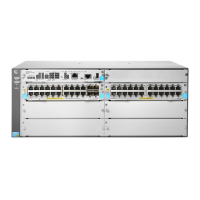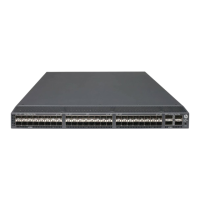132
Creating a VRRP group and assigning a virtual IPv6 address
A VRRP group can work correctly after you create it and assign at least one virtual IPv6 address for
it. You can configure multiple virtual IPv6 addresses for the VRRP group on an interface that
connects to multiple subnets for router backup.
Configuration guidelines
• If a router is the IP address owner in a VRRP group, do not configure the ospfv3 area
command on the interface to use the IPv6 address of the interface or the virtual IPv6 address of
the VRRP group, to establish an OSPFv3 neighbor relationship with the adjacent router. For
more information about the ospfv3 area command, see Layer 3—IP Routing Command
Reference.
• In load balancing mode, the virtual IPv6 address of a VRRP group cannot be the same as the
IPv6 address of any interface in the VRRP group.
• In VRRP load balancing mode, the device supports a maximum of MaxVRNum/N VRRP groups.
MaxVRNum refers to the maximum number of VRRP groups supported by the device in VRRP
standard mode, and N refers to the number of devices in the VRRP group.
• If you create an IPv6 VRRP group but do not assign any virtual IPv6 addresses to it, the VRRP
group stays in inactive state and does not function.
• To avoid IP address collisions, change the IPv6 address of the interface on the IP address
owner before you remove the VRRP group from the interface.
• The virtual IPv6 address of an IPv6 VRRP group and the downlink interface IPv6 address of the
VRRP group must be in the same subnet. Otherwise, the hosts in the subnet might fail to
access external networks.
Configuration procedure
To create a VRRP group and assign a virtual IPv6 address:
Step Command Remarks
1. Enter system view.
system-view
N/A
2. Enter interface view.
interface
interface-type
interface-number
N/A
3. Create a VRRP group and
assign a virtual IPv6
address, which is a link-local
address.
vrrp ipv6 vrid
virtual-router-id
virtual-ip
virtual-address
link-local
By default, no VRRP group exists.
The first virtual IPv6 address that
you assign to an IPv6 VRRP
group must be a link-local
address, and it must be the last
address you remove. Only one
link local address is allowed in a
VRRP group.
4. (Optional.) Assign a virtual
IPv6 address, which is a
global unicast address.
vrrp ipv6 vrid
virtual-router-id
virtual-ip
virtual-address
By default, no global unicast
address is assigned for an IPv6
VRRP group.
Configuring the router priority, preemptive mode, and
tracking function
Configuration guidelines
• The running priority of an IP address owner is always 255, and you do not need to configure it.
An IP address owner always operates in preemptive mode.

